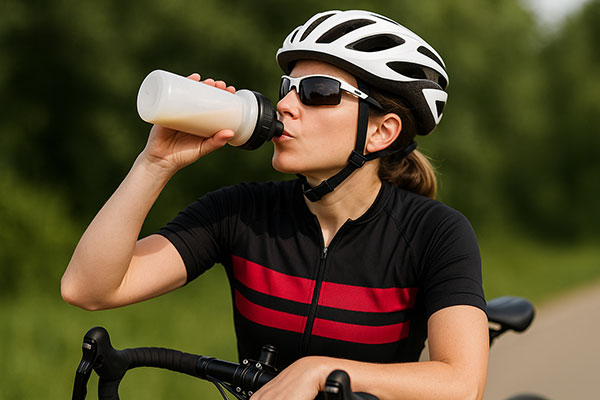As the days get shorter and the weather turns colder, motivation can dip, and training can feel tougher. Many riders keep their focus on getting the sessions done — but overlook one of the most important parts of performance: fuel.
Cycling isn’t just about power and endurance; it’s about energy management. What you eat, when you eat, and how consistently you fuel your body can make the difference between progressing through winter and starting the next season already tired.
This blog explores how to fuel smarter through the colder months — with science-based advice that’s easy to apply for both everyday riders and racers alike.
1. Why Winter Fueling Matters More Than You Think
It’s easy to assume winter training doesn’t need the same level of nutrition planning as the race season — after all, rides are often shorter, and many are done indoors. But that’s exactly where most cyclists go wrong.
When it’s cold, your body works harder to maintain core temperature. Even an indoor turbo session can burn more energy than you think, especially when paired with strength work or back-to-back training days.
At the same time, appetite can drop. You drink less, skip mid-ride fueling, and often under-eat after training. That creates an energy gap that builds up over time.
The result?
• Slower recovery
• Weaker immune function
• Poorer sleep
• Increased fatigue
Nutrition isn’t just about calories — it’s about consistency.
2. The Physiology of Energy Availability
Your body relies on a steady supply of carbohydrates and fats to fuel performance. But when energy intake doesn’t match output, you enter a state called Low Energy Availability (LEA).
LEA disrupts everything from hormone regulation to bone health. For endurance athletes, the early signs are subtle:
• Sluggish legs even after rest
• Loss of power at threshold
• Persistent fatigue
• Increased irritability or poor mood
In the long term, it can lead to Relative Energy Deficiency in Sport (RED-S) — a condition that blunts training adaptation and recovery.
Even small calorie deficits repeated over days can push you into that zone.
So while winter might feel like a time to “trim down,” it’s actually when you should prioritise recovery and energy balance.
3. How to Structure Winter Fueling
Think of your nutrition the same way you think of your training: periodised and purposeful.
a) Pre-Ride: Build the Base
Before every ride — even an indoor session — aim for slow-release carbs and a moderate amount of protein.
Example: porridge with fruit and honey, or toast with nut butter.
Why: carbs raise glycogen stores; protein slows digestion and improves satiety.
For early-morning rides, even a banana and a small bowl of oats 30–45 minutes before starting makes a big difference.
b) During the Ride: Stay Ahead of the Bonk
For rides over 90 minutes, fuel early — every 20–30 minutes.
• 30–60g of carbs per hour for steady endurance rides.
• Up to 90g per hour for high-intensity sessions (using mixed glucose/fructose sources).
Even indoor rides need fueling — sweat loss is higher, and dehydration can blunt power output.
If you’re training multiple days in a row, under-fueling even one ride compounds fatigue across the week.
c) Post-Ride: Recovery Starts Immediately
The 30–60 minute window after training is critical. Aim for:
• 1.2g of carbs per kg of body weight
• 20–30g of high-quality protein
Smoothies, Greek yogurt with fruit, or rice with eggs are great options.
This window helps replenish glycogen and kick-start muscle repair. Skipping it means starting your next session already depleted.
4. Common Winter Nutrition Mistakes
– Under-fueling “easy” rides
– Over-relying on caffeine
– Cutting carbs too aggressively
– Ignoring hydration
5. Winter Supplements Worth Considering
Nutrition should come primarily from whole foods, but a few supplements can help bridge seasonal gaps:
• Vitamin D: Less sunlight = lower vitamin D. Essential for bone health and immune support.
• Iron: Low energy or persistent fatigue may be linked to iron deficiency (especially in female riders).
• Omega-3 fatty acids: Support joint health and inflammation management.
• Electrolytes: Maintain sodium balance when sweating heavily indoors.
Always consider testing or consulting a qualified nutritionist before supplementing.
6. Balancing Performance and Weight in Winter
Many cyclists quietly chase two goals: build fitness and lean down. The problem is that these two processes don’t always align.
Winter is the time for building strength and resilience — not restricting calories. When training intensity is high, deficits only limit adaptation.
A better approach:
• Maintain consistent fueling.
• Focus on nutrient quality, not just calorie cuts.
• Use off-bike strength and mobility work to improve body composition naturally.
When spring arrives, you’ll have a stronger base to safely refine your race weight.
7. How to Apply This to Your Training
Here’s a simple way to put all this into practice:
Weekday Turbo Sessions
• Eat a light carb-rich meal 1–2 hours before.
• Sip electrolytes throughout.
• Small carb snack (banana, gel) if >75 mins.
• Recovery snack within 30 mins after.
Weekend Long Rides
• Breakfast: porridge + honey + fruit.
• Fuel every 30 mins with small portions.
• 500–750ml water per hour with electrolytes.
• Recovery meal: rice, chicken, and veg or a smoothie with oats + protein.
Rest Days
• Maintain protein intake (1.6–2g per kg body weight).
• Keep carbs moderate to support glycogen restoration.
• Prioritise micronutrient-rich foods (fruit, veg, nuts, seeds).
Consistency beats complexity. You don’t need perfect numbers — you need regular, reliable fueling.
8. The Coach’s Perspective
Coaches see the same pattern every winter: athletes train hard but stall because they’re chronically under-fueled. They think tired legs mean they need more intervals — but it’s usually the opposite.
A balanced plan combines training stress, recovery, and fueling strategy. When all three align, adaptation accelerates.
Athletes who nail their winter nutrition start the next season feeling fresh, not flat. Their sessions feel sharper, recovery faster, and progress smoother.
9. Bringing It All Together
Cycling improvement doesn’t come from one big change — it comes from dozens of small, consistent habits. Nutrition is one of those habits that multiplies the value of your training.
By fueling smarter through winter, you’ll:
• Recover faster
• Stay stronger
• Avoid illness and fatigue
• Build a deeper aerobic base
So, instead of cutting corners on calories, invest in your recovery.
Your spring self will thank you for it.
Key Takeaways
• Winter training burns more energy than you think.
• Under-fueling is the #1 cause of slow recovery.
• Structure nutrition like you structure training.
• Carbs and protein after every session are non-negotiable.
• Small, consistent habits = big results.
Next Step
Want to make sure your training and nutrition work together this winter?
Get a personalised coaching plan that balances both — helping you fuel smarter and ride stronger into next season.

